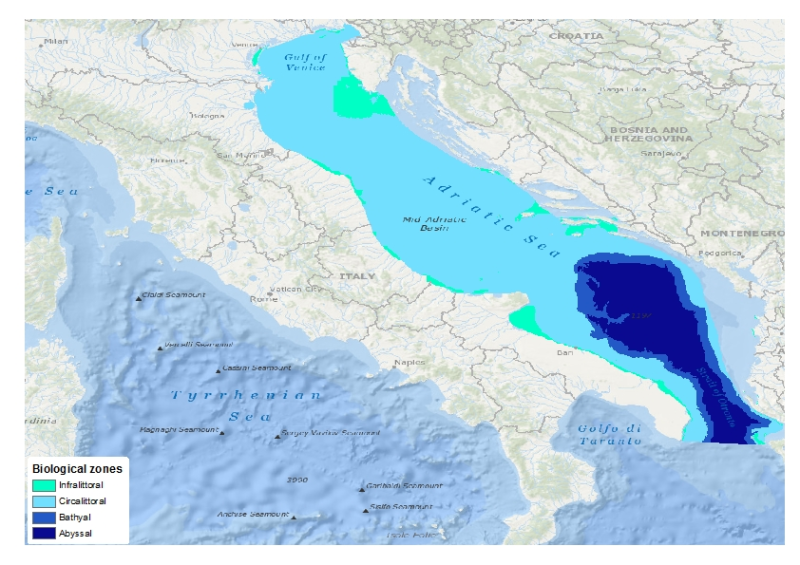Adriatic
Type of resources
Available actions
Topics
Keywords
Contact for the resource
Provided by
Formats
Representation types
Update frequencies
status
Scale 1:
-

This layer is a model of the biological zones of the Adriatic Sea. It was performed within the framework of EMODnet Phase 2 Thematic Lot n┬░ 3 (aka EUSeaMap2). It is a preliminary version which will be refined during the course of the project. This layer was modelled with the use of base layers that were the seabed substrate type (obtained from EMODnet phase 2 Geology lot, June 2014 release), the bathymetry (EMODnet phase 1 Hydrography lot) and the kdpar (bespoke computed layer) The biological zones boundaries were defined in the following way. - Infralittoral lower limit: limit at which the percentage of light reaching the seabed is 1%. The percentage of light layer was calculated by intersecting the kdpar and the bathymetry layers. For more details about this calculation see e.g. Cameron and Askew (2011). - Circalittoral lower limit: break of slope due to the entrance into the continental slope. This limit was digitalized with the use of the bathymetry layer - Bathyal lower limit: break of slope due to the entrance into the abyssal plain. This limit was digitalized with the use of the bathymetry layer In a western area for which the seabed substrated type is influenced by the P├┤ river, different rules were used for the definition infralittoral and circalittoral zones. Where the substrate is muddy (i.e. mud or sandy mud) and/or the seabed is deeper than 20 meters then the biological zone was said to be circalittoral. Elsewhere it was defined as infralittoral. For more details about the current layer see EUSeaMap first year report (EMODnet Thematic Lot n┬░ 3, 2014) Cameron, A., Askew, N. (eds.), 2011. EUSeaMap - Preparatory Action for development and assessment of a European broad-scale seabed habitat map final report. URL: http://jncc.gov.uk/euseamap EMODnet Thematic Lot n┬░ 3, 2014. EMODnet Phase 2 - Annual (interim) report. Reporting Period: Sept. 2013 to Aug. 2014. URL: http://www.emodnet-seabedhabitats.eu/pdf/20140909_euseamap2_year1_report.pdf
-

This layer is a predictive EUNIS seabed habitat map for the Adriatic Sea. It was performed within the framework of EMODnet Phase 2 Thematic Lot n┬░ 3 (aka EUSeaMap2). It is a preliminary version which will be refined during the course of the project. The layer was created using two pre-processed input datasets: substrate and biological zone. The seabed substrate type layer was a compendium of historical maps (Emodnet phase 2 Geology lot first release + IBCM map). The biological zones layer, available in this catalog under the title 'Biological zones of the Adriatic Sea', was modeled thanks to layers of bathymetry and light attenuation. The map follows the EUNIS 2007-11 classification system. It does not include the intertidal zone. The study followed the methodology developped within the EUSeaMap project (EMODnet phase 1). For more details about the methodology see EUSeaMap final report (Cameron and Askew, 2011) or Coltman et al., 2008. For more details about the current map see EUSeaMap2 interim report (EMODnet Thematic Lot n┬░ 3, 2014) Cameron, A., Askew, N. (eds.), 2011. EUSeaMap - Preparatory Action for development and assessment of a European broad-scale seabed habitat map final report. URL: http://jncc.gov.uk/euseamap Coltman, N., Golding, N., Verling, E., 2008. Developing a broadscale predictive EUNIS habitat map for the MESH study area. 16 pp. URL: https://www.emodnet-seabedhabitats.eu/resources/mesh-archive/. EMODnet Thematic Lot n┬░ 3, 2014. EMODnet Phase 2 - Annual (interim) report. Reporting Period: Sept. 2013 to Aug. 2014. URL: http://www.emodnet-seabedhabitats.eu/pdf/20140909_euseamap2_year1_report.pdf
 EMODnet Product Catalogue
EMODnet Product Catalogue